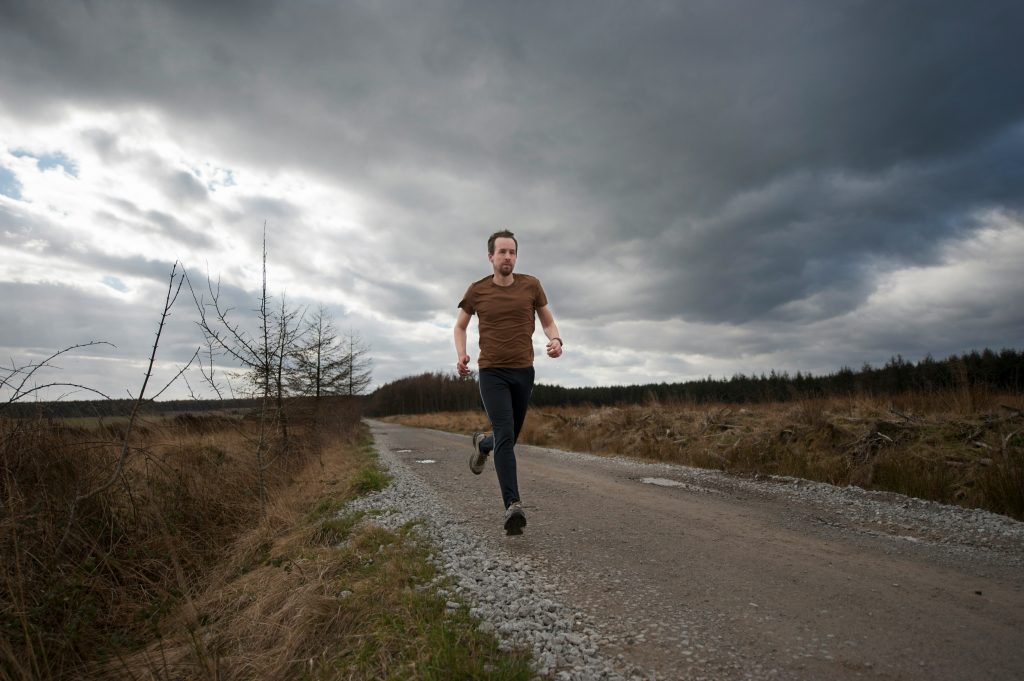More mind games for long distance training.
Training for the first multi-days was mainly long distance walking. I was struggling with running for some reason but I still had energy and a yearning for the epic races; those events where the mere thinking about them gives you a little tingle of joy and transports you out of the mundane daily round. The big push was generally three and a half months prior to the April race in New York and meant regular sixty to eighty mile weeks and sometimes up to a hundred miles (I think I managed 200k as well once or twice). It sounds a lot but it was almost all walking in those days (at a reasonable pace) rather than running. A change of job and location had given me some extra time.
The key was to get out twice a day and do a good morning session followed by a similar or slightly shorter one in the evening. Along with that I had plenty of mental distraction in the form of music, audiobooks and foreign language courses. I remember listening to all of War and Peace and learning some basic Greek!1 (i used to enjoy learning languages as a kind of hobby). If you are blocked with running and have the patience to walk, then it can be very strengthening and empowering as you start covering a lot of miles. It can also get you a reasonable result in a multi-day race.

I think double sessions are the key to getting your mileage higher. Even if you can add an hour of fairly easy walking every evening, that equates to almost thirty miles per week, which on top of your daily total will give you a huge boost. With cold water sea swimming it was the only way I could get longer times, as I found in the mornings an hour was usually my maximum because of the water temperature, but it was not too hard to go back and do an easy three-quarters of an hour in the evening (this depending very much on your circumstances of course – I was lucky to live five minutes from a beach at the time).
Also with double sessions you can take a rest day by skipping a morning or an evening, which will still give you 24 hours off. I’ve always found full rest days problematic as the mind needs them but you don’t tend to rest that well and it’s hard to get going again.
If you want to get a really good week’s training to keep the mind happy, then a trick is to add a session the evening before your week starts and a short session on the morning after the week ends. You can squeeze another ten or perhaps more miles out of this and further down the line your mind will not be able to split hairs with you and you will be able to claim it as your mileage over a week. It might just be what you need to rack up that sixty or hundred mile week, which will give you confidence going ahead. The rigid mind will say that its ‘mileage week’ has to be an exact week but it won’t notice if you just tamper with it slightly. So an easy change might be, instead of starting on Monday morning, start on the Sunday evening and finish on the following Monday morning (seven full days plus two extra sessions).

If you do two sessions a day then you have 16 session and you might find it much easier to amass a really good ‘weekly’ mileage. Even if you just walked (and assuming a 15 min mile pace) and did an hour for each session then you would clock up over 60 miles that week. Perhaps you could even make the evening one easier by doing half an hour or even twenty minutes at lunchtime (of course depending on circumstances). Then just have the confidence to start your next week on the Tuesday evening or maybe Wednesday morning. The mind will accept these as being training weeks and you will have a good confidence-boosting mileage. If you wait until the Wednesday to start again then you will have had three sessions off which psychologically feels a lot. When you reach a tough point in an event, and your mind is telling you that you might as well pack up and go home, you will have this solid bargaining chip to say to it that you have done certain long mileage weeks. It won’t try and tell you they were not absolutely within a span of 7 days. It will move on to the next big gripe but you will be equally prepared to fight it off again!
In order to get through the daily miles a little sleight of hand does not go amiss. For some reason one gets fixed on reaching certain numbers, despite the fact that nobody is going to know and ultimately it probably does not make that much difference. It can be very good for the mind, though, to have reached certain distances – fifty or sixty mile weeks for example. It is said you can always tell an ultra-runner, because they go backwards and forwards past their front door multiple times before ending the run. I know exactly that situation where you are desperately trying to get to a round figure or squeeze that extra mile out. Anyway the urge to get to these milestones can put you under quite a bit of pressure and I would find the evening winter sessions particularly difficult when it was cold, dark and invariably blowing a hooley.
One evening route I used quite a bit took me out of the house and up the hill for just over half a mile (it was quite a remote area with not that many other houses around). At that point the road levelled out and I could do a quarter of a mile on the flat. To make it exactly 2 miles back to the house some other shimmies were involved in the other direction from the house, going down to a phone box and repeating that twice. Nothing ever seems to be an exact distance when you want it to be. This inexactness though can work in our favour as it helps throw the mind off track. The initial tendency is just to attack the loop and go back and forth as many times as necessary to get your desired mileage (up and down for 2 miles and then religiously repeating that for 4 miles or however many you want to do in total). For me that quickly didn’t work as it would have meant doing the hill repeatedly which was going to make it too difficult with the higher mileage goal. Also coming back to the house and seeing the lights on makes it very hard to go back out again in the dark and wet for another loop.

So what I did was get up to the flat part and then start building up the distance there. It’s an inspiring place to walk with fields, occasional views down to the sea and hedgerows filled with abundant wild flowers. Since it is quite remote, if it is clear then the early evening night sky can be full of interest. Walking back to the south west I was always amazed at how bright Sirius and the stars of Orion’s belt were. It’s also that time of day when you see a surprising number of satellite flares as high in the atmosphere the sun is still reflecting off their solar panels. Since it was fairly flat I was able to get a good rhythm going and ignore the watch as on a half mile loop you can’t really lose track of your distance if you know what time you started.
The top of the loop at the turnaround point was the most remote and windswept, whilst further down towards the start, where there were more lights and houses, it was easier. At the top of the lane there was always a slight feeling of unease or mild fear, not the fear one might associate with staying in a haunted house perhaps, but nevertheless enough to make it more mentally demanding. 2 You are also at the furthest point from the beginning of the loop and the end of the session. That’s fine if it really is the start of the journey home and the end of the session but, if you are going to be returning to it (maybe more than once), then it can become mentally tough. This is a subtle thing I think and not something we will readily admit to the proud mind that is battling on with it all. But it’s like a weak point in the scaffolding – that part of the course is no harder from an objective material point of view – yet subjectively and psychologically it is.
One evening, feeling fed up with being in the middle of nowhere, and with four of the short half mile sections at the top of the lane left to do before returning down the hill to the end (in other words four more times back to the furthest turnaround point) , I discovered a new trick. I started heading back at the turnaround point (endpoint of the out and back) in the normal way but after about 200 metres I turned back again instead of continuing in the normal way. I then repeated that four times. The new place that was 200 metres or so back from the turnaround in the direction of the start then became the new turnaround. In this way you can get the hardest bit of the course completely out of the way in one go rather than having to wait for it to come up again on each mini lap. I then repeated that same process from the new endpoint and slowly brought it nearer home. Somehow for the mind it was much easier as it was more like having only one loop left as opposed to four. The mind also starts to get slightly confused over how much is remaining and it starts to switch off to a certain extent. It will be clear how far you have gone from the time on your watch and even more so if you are using GPS. In a sense you are grasping this rather fixed challenging thing out there in the dark and slowly bringing it back nearer home, knocking it off its pedestal.

That’s the basic principle, but once you start really applying it then the possibilities are endless. As you do this you start dividing your course up into lots of shorter sections. A feature of the road, a certain branch sticking out of the hedge, a gate, really anything can serve as a mark.You can pick parts at random and just get them done before the other sections, even going back and forth between them multiple times if you are doing repeats on an out and back course. You might end up with some middle or end sections completed before beginning sections. It really will all add up in the end, it’s just a question of trying to keep a tally of what you’ve done. It’s very similar to the process I described (see here) on the 10 day race where one can do evening loops (trickier ones for the mind) during the afternoon. Mathematically and quantitatively one loop is no different from another one, yet bring in a different part of the mind and suddenly they can start to have their own unique character. An evening loop is qualitatively different from an afternoon one (to start with even just due to the fact that it’s light and you are probably less tired then).
The more creative relaxed part of the mind will then be engaged in working it out and adding it up, all of which helps to quieten the frustrated part of the mind that just wants to know how much longer there is to go and to get it all over with. It also means you can keep going without knowing how much is left. If you can convince your mind that there is less remaining or at least a very manageable distance, then naturally it becomes easier.
I really felt the strength of it all when I applied the same principle on my longer weekend route. I had a basic three mile out and back stretch which gave me six miles. There were also two three-quarters of a mile spurs off the main stretch (cul-de-sac roads leading off the main route) . Already without fiddling about with the sections there were quite a few possibilities.
A simple one was to do the out and back (six miles) and go up and down each of the spurs on the way back giving a total of nine miles. Variations on that would be to do the spurs on the way out instead, or perhaps do them twice in total, once on the way out and once on the way back. For a longer session I might want to do that whole thing twice, in other words out and back twice and each spur a total of four times overall. Once you decide to do that the mind gets hold of it and is thinking it has a 24 mile session ahead of it. You are drained before you leave the house.

So the first step is to suspend the mind’s final judgement – know deep down that you might be embarking on 24 miles but don’t let the mind look at this full on in a dry and categorising kind of way. Tell the mind that you are going to be doing a few bits and pieces and that it is welcome to add it all up. Then what you could do is, as you get to each spur, use the technique I described earlier. The plan eventually is to do each three-quarter of a mile spur four times (6 miles per spur – one and a half miles multipled by four). But to lessen the mental strain, as you get to the end of the first spur, start making your way back along it to the main road in the usual way but turn back again at some arbitrary point, say a quarter of the way or half of the way back (marking with a stick or branch as discussed above). Then go with your inner feeling – you could do that four times in which case that whole second half of the first spur is now completed, or you could do a part of it. Apply the same technique when you get to the second spur and perhaps you could leave this one with a different number remaining. Then for the main loop of three miles do exactly the same thing, so when you are half a mile back from the turnaround (or whatever point you choose on the day), go back and redo that. It will start to feel as if you have all sorts of spinning tops revolving on different parts of your course. When it starts to work it is an extraordinary feeling as you can start to feel that not only are going to finish but that you are not so far away from the end. You are saying to yourself perhaps that you need to go back up the main route once more but are relieved that you don’t need to run the whole way, then you know you maybe need to run back up one of the spurs again but this time it’s only to the halfway point and rather than having to do it twice you in fact now only have to do it once. Then you maybe have some other little shimmy to do somewhere before it’s time to run home. I’ve had the experience doing this where quite early on, in for example a three hour run perhaps after 30 minutes, I would have the strong feeling that I was almost done. Of course the gloomy mind would charge back in and ridicule the whole thing telling me I had only done a few miles and had another 15 to go. At that stage the creative part of the mind feels like a child who has just had his or her dreams crushed by something all to real from the adult world but if you can just keep the little dream or deception ticking over it will quickly give you energy and hope again. It’s then a question of working hard at trying to stop the mind from barging in and ruining it all again. The longer you keep going the further the mind seems to retreat until there is a point where it seems to evaporate and you often start to really enjoy the session. Sometimes it dawns on you that maybe this is how it is meant to be that it can be fun and enjoyable – it really doesn’t need to be something painful that you want to get over with as quickly as possible.

The tricky part of your mind will be a bit quietened and slightly confused whilst the more creative part will be quite busy figuring it all out. You will have a surprisingly good idea of where you are and what is left but if you don’t it’s always on the watch and GPS (if you are using). Psychologically it can be an amazing boost as for the mind you effectively are doing one out and back and each spur once, so you effectively cut your distance in half. It may seem fanciful but this really is the level of deception that you can carry out on the mind and indeed may be the only way through the longer ultra events.3
Also it’s not the case that you are unable to do other things like listening to your audio or looking at the trees. It is always daunting when you are tired on a first loop, knowing that you will have to go back and do it all again, but somehow this way it just seems like you only have one loop to do. You take the rather daunting distance and stamp your own individuality on it, mapping it out in your own subjective way. With this kind of approach I often have the experience of going through my individual mind map of what I have to do and really not feeling that it is going to be too much further. Then when you let the calculating part of the mind intrude, which of course we would rather not do but can’t always stop completely, then you can be brought right back down to the stark reality of it and see that you have barely scratched the surface of the distance.
The more you can stay with your own schedule the better and after a while the mind seems to give up and just accept it. Perhaps this either is or should be where we focus our will power rather than on trying to push through perceived pain and other physical barriers. We get better at this mental jugglery the more we practice it until it starts to become second nature on all our training sessions. I don’t think you can wait until the event comes around to start trying to apply these things, anymore than you would wait until the starting line to do your first long run! This may well be more what mental training is, rather than it being some perceived idea of willing ourselves to be strong or building up some kind of mental muscles.

It’s almost as if the whole point of ultra distance events is to make the time and distance too much to get one’s head around. This forces you to make a change and not only do you learn something most significant from it but it changes you and what surrounds you. Imagine you are a competitor in the Self Transcendence 3100 mile race (the world’s longest certified foot race) and on the first day you successfully manage to complete sixty miles having run around a New York block all day in the scorching summer heat. It’s likely that the mind will be freaked out at the prospect of having to do that for another 52 days just to finish the distance inside the cut-off time. For me I always experienced this mental meltdown early on in my channel swims. After a few hours, when I was cold, tired, seasick and completely fed up with the whole idea, it struck me hard that it was necessary to keep going for anything up to another 15 or 16 hours.
One part of the mind seems to find these distances terrifying and impossible. It feels like something totally exterior to our delicate human frame, no matter how strong and fit we might be. It is external time, gloomy, mechanistic and out of one’s control, like something cast in iron for eternity. The Greek god Kronos, often portrayed as a callous old man with a grey beard, personifies this destructive and stifling aspect of time.
Yet it might be possible to wrest back some control and not let it be totally the master of you. Partly this can be done by not thinking about it but this is hard and far easier said than done. It’s like in a meditation class when the instructor jokes with you and introduces an exercise to practice stilling the mind but tells you that you are not to think of a pink elephant at any stage. Of course one ends up spending most of the five minutes focused on just that! The point is that you cannot really put those kinds of thoughts out of your mind but what you can do is focus all your attention on something else in such a way that the elephant disappears into the periphery. So there are techniques which can help but the most beneficial is to try and engage and impose your own subjective time on the outer time.
You accept and embrace the mechanistic time but you slowly tame it just a tiny bit through your own imagination and creativity. Messing around with the loops and distances in the way I have described enabled me to start touching on this. It can be fun too and helps put a spring back in your step. I certainly found that it was what enabled me to get through the long miles of training and indeed what got me through the race in the end as well. By breaking the distance up into all sorts of more manageable chunks and only focusing on them one at a time you can slowly calm the restless complaining mind. By taking certain small chunks out of their normal temporal position and rearranging them as you want, shifting them with your imagination and by tapping into your own subjective inner time, you can perhaps disrupt the rigid flow of time imposed from outside.
- Funnily enough now on the events I’m more limited in terms of what I’m able to concentrate on or listen to and could no longer, for example, follow an audio book. I think that’s because finally after all these years I’m now able to run more of the distance instead of power walking. ↩︎
- Coming from a long swimming background one thing I always noticed about sea swimming was that you are always very slightly on edge (sometimes a little more than slightly too!) due to the environment. You are swimming over dark patches of weed, rocks and essentially the unknown. There are no dangerous sharks in UK waters but the mind is constantly inventing scenarios and you can often make out the jaws theme tune in the background. That fear does lift after a few hours (and I’ve written about that elsewhere) but it seems to be a very slight drain on the energies. I noticed it very strongly whenever I did or didn’t have a helper on the beach for my longer 6 hour swims. Just the presence of someone else on the beach, even if you were quite a long way from them, gave tremendous energy and moral support. When there was nobody around it was always much tougher. This was the feeling at the top of these loops where there was nothing overtly frightening but at the same time you still felt on edge. That is always a drain on the mental energies somehow and adds to the difficulty. ↩︎
- 2. Often these mind techniques are small things that might give us a bit of an edge but sometimes they can be what I like to think of as major deceptions. In the book Sport and Meditation, Sri Chinmoy advises that when running the marathon you just imagine you are running 13 miles only. It can’t be an idle thought or mere idea but has to be envisaged with full determination. It seems it may be possible to provoke a complete upheaval of the mind’s rigid view of it all. We are not going to try and convince ourselves we are running say 25 miles but slightly cheekily make it half the distance. Just as the mind is the arch trickster, so too perhaps another part of us can pull off a major scam on the mind. ↩︎
